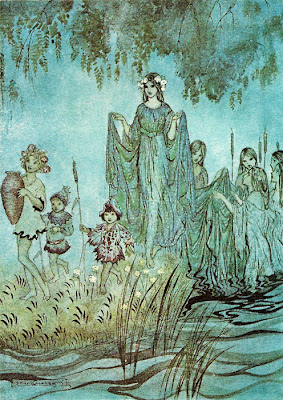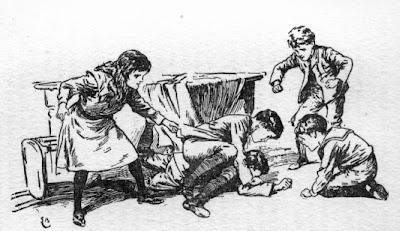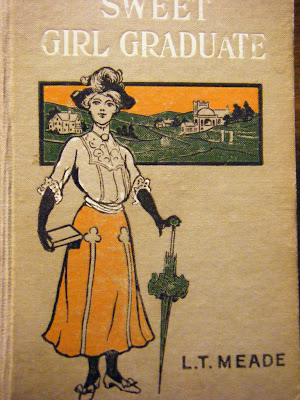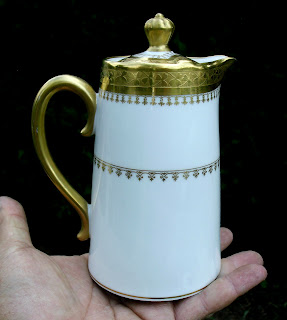(The 1922 edition of The Beloved Vagabond.)
First of all, Betsy and the Great World is wonderful, and so are all of the other books in the Betsy-Tacy series. Maud Hart Lovelace wrote them as a fictionalized autobiographical account of growing up in Minnesota in the late 1880s and early 1900s. (I love all fictionalized autobiographies of girls who grow up to be writers: Little House on the Prairie, Emily of New Moon, Little Women.) The Betsy-Tacy books begin when Betsy is five, and they go through her high school and college career to the first year of her marriage (1917). Betsy and the Great World is the one where Betsy spends a year traveling in Europe: 1914, the year that Maud spent abroad in real life.
(Illustration by Vera Neville from Betsy and the Great World.)
On the ship crossing the Atlantic, Betsy meets several people, including the rakish Mr. O'Farrell, her shipboard crush. Everyone begins to discuss books:
"Shouldn't an author know the classics?
But people at dinner tables, she discovered, didn't talk about the classics much.
Fortunately she had one dear love among books that was not a classic. And Mr. O'Farrell mentioned it.
'The Beloved Vagabond? Why, I've read that over and over!' Betsy cried."
The Beloved Vagabond is about a man called Paragot and his eccentric, bohemian life. Betsy and Mr. O'Farrell both admire Paragot, but not everyone on board agrees.
"The English lady knew Paragot, too. 'But I wished he'd cut his nails,' she remarked. 'And I didn't like it when he put his hairbrush in the butter.'"
So after that I had to read The Beloved Vagabond. I always take reading recommendations from my favorite fictional characters. Plus, I wanted to find out what the deal was with the hairbrush in the butter.
(Title page of the 1922 edition, from this Ebay sale that is sadly over.)
The Beloved Vagabond wasn't a classic when Betsy and Mr. O'Farrell were discussing it, because it had just been published nine years earlier, in 1905. I'm not sure whether to call it a classic now. Are die-hard Betsy-Tacy fans the only ones reading this book in 2012? But it was incredibly popular when it first came out. In 1907, Hamilton Carr gave it this rave review:
"He who has not read 'The Beloved Vagabond' has missed something quite unique in current fiction. It is a fantastic picture of compelling charm, extravagant in enticing details, at times broadly realistic and always human. Its scheme is a daring one, and because of it there is reflected an irresistible atmosphere of vagabondage, where untrammeled volition trips gayly across the years to the eternal melodies of the soul's emancipated glories."
An irresistible atmosphere of vagabondage, you guys! I need to start writing my reviews more like Hamilton Carr.
(You can find lots of screenshots from the 1936 movie here.)
(Image from here. No way was Paragot this clean-cut and suave.)
The whole point of The Beloved Vagabond is the remarkable character of Paragot. You meet him, you marvel at his spectacular weirdness, and you fall in love with him. Paragot begins the story by saving the narrator of the novel, then a London street urchin, by purchasing him from his neglectful mother for half-a-crown, which I think is like twenty cents. The boy sees Paragot as a god, even though Paragot is horrifyingly messy:
"Paragot lay in bed, smoking a huge pipe with a porcelain bowl and reading a book. The fact of one individual having a room all to himself impressed me so greatly with a sense of luxury, refinement and power, that I neglected to observe its pitifulness and squalor. Nor of Paragot's personal appearance was I critical. He had long black hair, and a long black beard, and long black finger-nails."
Okay, so I'm with Maud Hart Lovelace's English lady here. I want Paragot to cut his fingernails. And maybe to clean up his room a tiny bit:
"The herrings and a half-smoked pipe shared a plate on the top of the rickety chest of drawers. I had to blow the ash off the fish. A paper of tea and a loaf of bread I found in a higgledy-piggledy mixture of clothes, books and papers. My godlike friend had carelessly put his hair-brush into the butter."
That last sentence is perfection.
(Dulac's illustration of Paragot's meeting with the narrator.)
Paragot turns out to be kind-hearted, capricious, and given to lengthy philosophical speeches. He saves people everywhere he goes, he never follows social conventions, and he has a secret, tragic love affair in his past. At first, the story of Paragot is just an entertaining romp through his devil-may-care life. But by the end of the book, the story got really gripping. I was dying to know what would happen to Paragot, and I was ready to weep angry tears if I didn't get the ending I wanted. Then I finished the book and I wanted to read it again. Possibly after cleaning my house and getting a manicure, though.
(Paragot under a tree with his friends, living a life free from the demands of nail care.)


















































